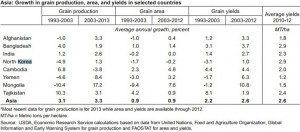ROME/PYONGYANG – A nationwide assessment by two United Nations agencies shows an increase in staple food production in the Democratic People’s Republic of Korea (DPRK) for the third year running.
The report, however, notes that although rates of child malnutrition have steadily declined over the past 10 years, rates of stunting caused by malnutrition during the first 1,000 days of a child’s life remain high and micronutrient deficiencies are of particular concern.
The joint Crop and Food Security Assessment Mission to the DPRK by the Food and Agriculture Organization (FAO) and World Food Programme (WFP) visited all nine agricultural provinces in late September and early October around the main annual cereal harvest.
Total food production is estimated at about 5.03 million metric tons (including milled rice) in 2013, which is about a 5 percent increase over the previous year. Despite the improved harvest, the food security situation is still unsatisfactory with 84 percent of households having borderline or poor food consumption.
The mission observed immense logistical challenges for the public food distribution system and expressed concerns about the timeliness and consistency of distributions. Markets and informal mechanisms of bartering and other forms of exchange are believed to be of increasing importance for access to food by families, particularly in urban areas.
“Despite continued improvement in agricultural production, the food system in the DPRK remains highly vulnerable to shocks and serious shortages exist particularly in the production of protein-rich foods,” said Kisan Gunjal, FAO economist and co-leader of the mission. “In the interest of increased protein consumption and to reverse the downward trend of soybean production, the price paid to farmers for soybean should be increased.”
Since 1998, WFP in partnership with the government has produced blended fortified foods and nutritious biscuits for children and pregnant or nursing women. WFP has recommended a shift to a new product – Rice Soya Milk Blend – for children in nurseries to reduce stunting and wasting.
“Improving the diversity and quality of food provided through the child institution system is essential to improving children’s nutrition,” said WFP DPRK Country Director Dierk Stegen. “We want to produce Rice Soya Milk Blend but can only do so if we receive sufficient donor support.”
Despite a small reduction in the area planted, overall crop production in 2013/14 is estimated to increase due to generally favourable weather conditions that resulted in a higher rice crop.
The aggregate production from cooperative farms, plots on sloping land and household gardens estimated by the mission includes the 2013 main season harvest and the forecast for 2014 early season crops. Unusually early and heavy rains in July and early August compromised maize and soybean yields but had little effect on paddy.
The report estimated cereal import requirements at 340,000 metric tons for the 2013/14 marketing year (November/October). Assuming the official import target of 300,000 metric tons of cereals is met, there remains an uncovered food deficit of 40,000 metric tons for the current marketing year.
While this food gap is the narrowest in many years, it needs to be bridged either through additional purchases by the government and/or international support to avoid increased undernourishment during the current marketing year.
To improve food security and nutrition, the report recommends national and international support for sustainable farming practices, better price and market incentives for farmers and improvements in farm mechanization.
In nutrition, the report recommends that efforts should go toward improving dietary diversity and feeding practices for young children and women through strategies such as behavioural change, market reform and encouraging livestock and fish production; strengthening treatment of severe and moderate acute malnutrition; and better hygiene and sanitation practices.

